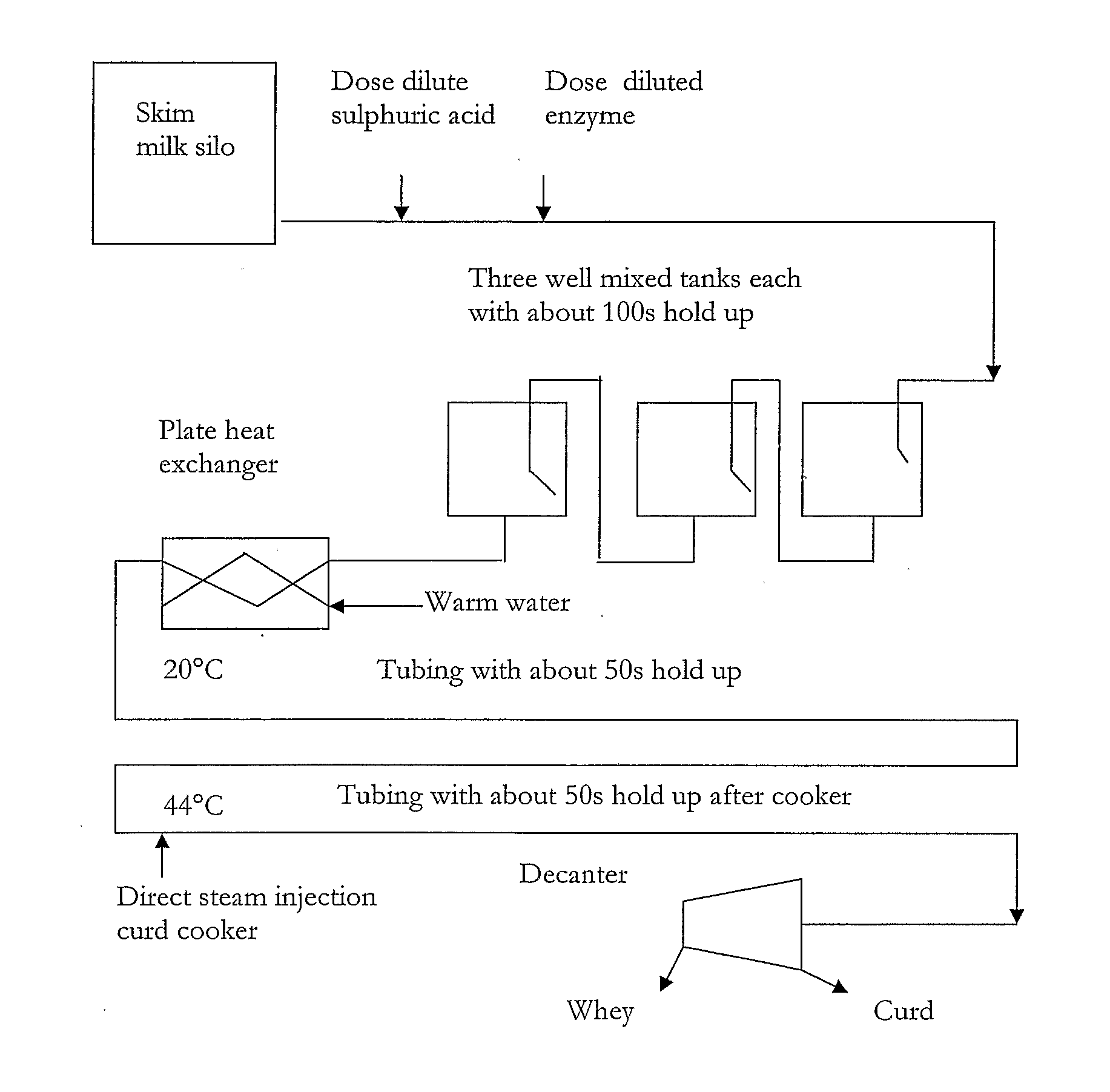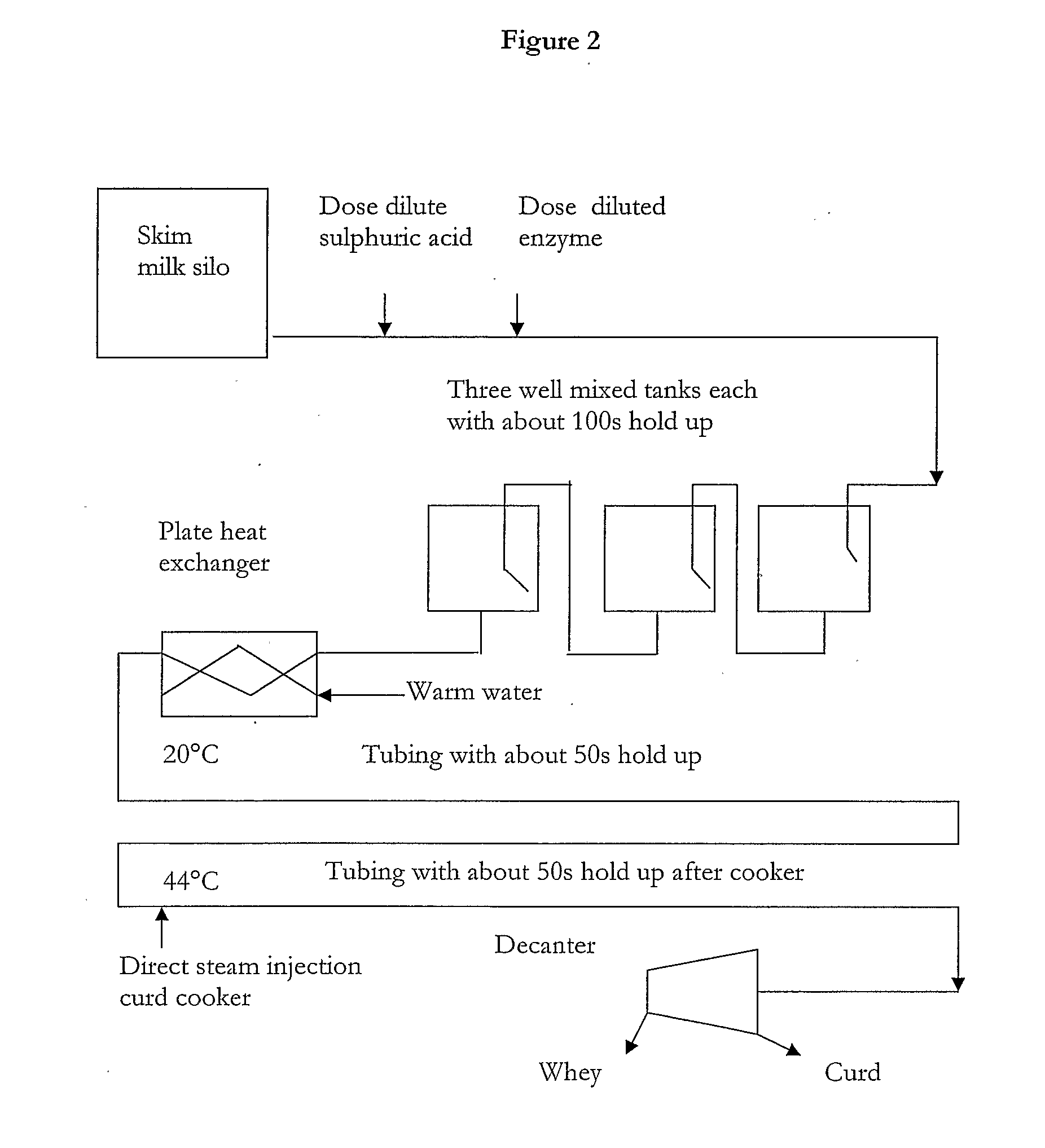In-Line Continuous Flow Process for Making Cheese
- Summary
- Abstract
- Description
- Claims
- Application Information
AI Technical Summary
Benefits of technology
Problems solved by technology
Method used
Image
Examples
example 1
Initial Laboratory Bench Trial
[0089]The following parameters were used for the laboratory trial:[0090]Low fat fresh skim milk with pH 6.73[0091]200 mL of skim milk sample was used for each trial.[0092]Two setting temperatures were used 12° C. / 20° C.[0093]Three milk / pH adjustments and a control milk were used i.e. pH 5.4, 5.7, 6.0 and 6.73 (control).[0094]A rennet enzyme level of approx 1.0 L to 20,000 L of skim milk (Renco® liquid natural calf rennet [activity 280 IMCU / mL], Dairy Meats N.Z. Ltd., Enzyme Division, Eltham, New Zealand) was used.[0095]All samples were timed to form a coagulate (clot) suitable for conversion into curds and whey.
Results
[0096]Table 1 gives a summary of the outcome of 8 laboratory experimental trials as proof of concept.
TABLE 1Clotting times for pH-adjusted milks at two milk-setting temperatures.ReactionFreshtemperatureVolumeAdjustedEnzymeSettingskim milk(° C.)(mL)milk pHadditiontime (s)CommentsControl282005.452 drops60Very Firm282005.712 drops100Very Firm...
example 2
[0099]1,800 L of skim milk (pH 6.7) was cooled to 12° C. and 450 L and 1350 L placed into small silos and four trials carried out as described below and as set out in FIG. 1.
Trial 1 (Control)
[0100]450 L of skim milk at 12° C. was pumped to another vessel and 50 mL standard strength rennet (as above) was added (1 mL per 9 L), rapidly mixed and then allowed to react overnight. The following day, the reacted milk was pumped to the cooker. In the line carrying the milk to the cooker, acid (0.25M sulphuric acid) was added to reduce the pH to 5.45 and at the cooker steam was injected into the line to raise the temperature of the enzyme treated and acidified milk to about 43-44° C. to induce clot formation and cook the clotted milk. After a further in line holding time of about 50 s, the mixture of curds and whey were pumped into a horizontal bowl centrifugal decanter (Sharples model J83P2000, Pennwalt Corporation, Warminster, Pa.) to separate the curds from the whey. A sa...
example 3
Scaled Up Trials Using Triple Stirred Tanks
[0108]2000 L pasteurised skim milk was pumped through the plant at the rate of about 2000 L / h. The plant was configured as shown in FIG. 2. Dilute sulphuric acid (2.5% w / w) was dosed into the milk line to reduce the milk pH to the required value (either 5.4 or 5.9). The pH of the acidified milk was monitored by bleeding a small stream off into a small container holding a calibrated pH electrode.
[0109]Trials used calf rennet (as described above) or a microbially derived protease, Fromase 750 XL (approximately 800 IMCU / mL), supplied by DSM Food Specialities, Sydney, Australia. The enzymes were diluted with water prior to dosing into the milk. 300 mL of calf rennet was diluted with 20 L of water, and 100 mL of Fromase was diluted with 20 L of water. The milk clotting enzyme was dosed into the milk line at a rate to give an equivalent activity of about 36 international milk clotting units (IMCU) per litre of skim milk (at pH 6.7). After a brief...
PUM
 Login to View More
Login to View More Abstract
Description
Claims
Application Information
 Login to View More
Login to View More - R&D
- Intellectual Property
- Life Sciences
- Materials
- Tech Scout
- Unparalleled Data Quality
- Higher Quality Content
- 60% Fewer Hallucinations
Browse by: Latest US Patents, China's latest patents, Technical Efficacy Thesaurus, Application Domain, Technology Topic, Popular Technical Reports.
© 2025 PatSnap. All rights reserved.Legal|Privacy policy|Modern Slavery Act Transparency Statement|Sitemap|About US| Contact US: help@patsnap.com



